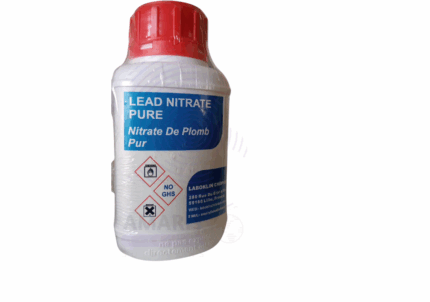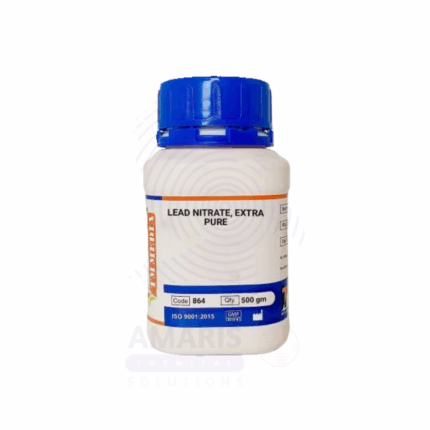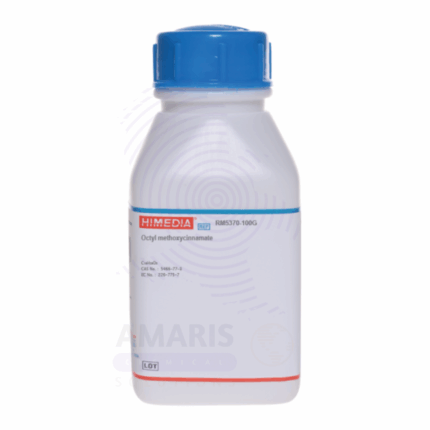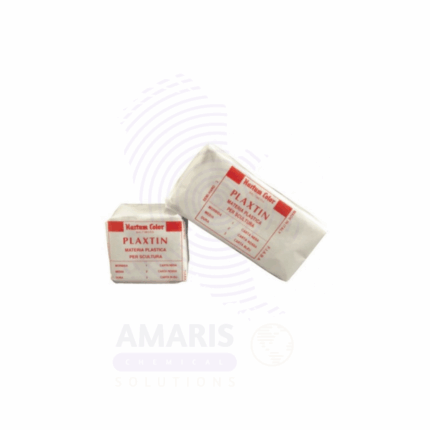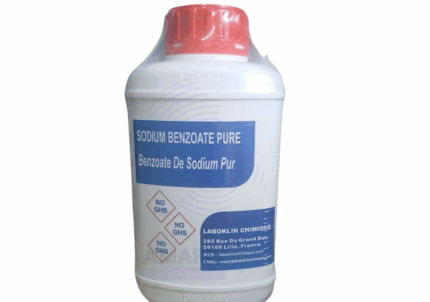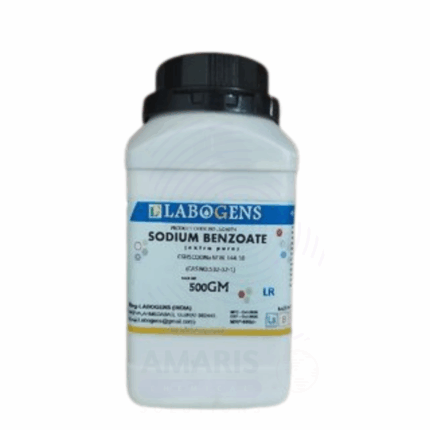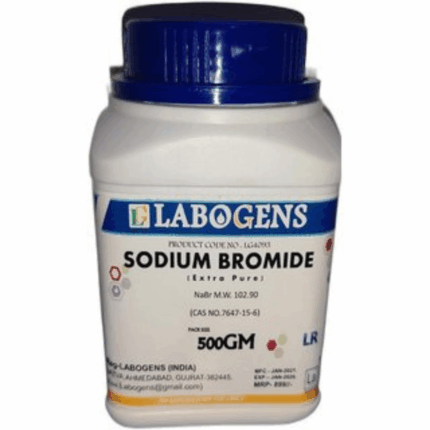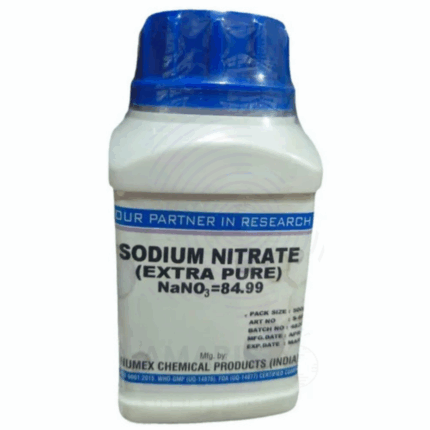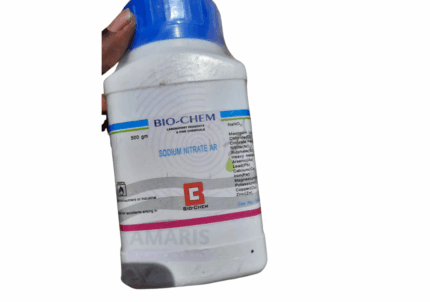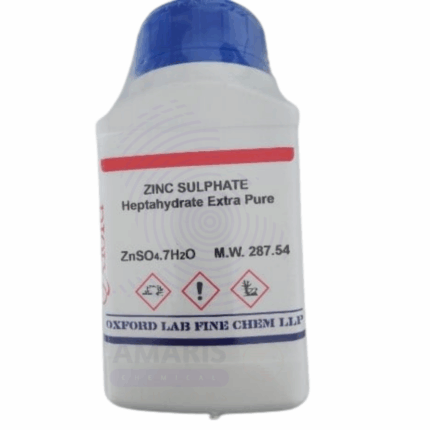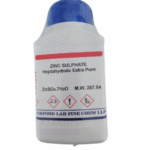
Zinc Sulphide Extra Pure
$ 18.00 Original price was: $ 18.00.$ 17.87Current price is: $ 17.87.
Zinc Sulphide Extra Pure is a high-purity, white to pale yellow, odorless crystalline or powdery inorganic compound with the formula ZnS. It is widely used as a phosphorescent and luminescent material in laboratory and industrial applications. Known for its excellent optical properties, it serves as a key reagent in analytical chemistry for spectroscopic standards and as an activator in glass and ceramics. In pharmaceuticals and cosmetics, it acts as a UV blocker and luminescent agent.
Due to its inert nature and stability, Zinc Sulphide Extra Pure is ideal for use in paints, safety coatings, and electronic devices requiring phosphor materials. It requires careful handling to avoid dust inhalation and must be stored away from acids and moisture to prevent release of toxic hydrogen sulfide gas.
Zinc Sulphide Extra Pure
PRIMARY USES
- Analytical Reagent & Laboratory Applications:
- Used as a luminescent material in qualitative and quantitative chemical analysis.
- Acts as a phosphorescent reagent for detection and measurement in analytical chemistry.
- Employed in preparation of calibration standards for optical and spectroscopic studies.
- Glass & Ceramics Manufacturing:
- Used as an activator and opacifier in glass and ceramic formulations.
- Enhances luminescent and fluorescence properties in specialty glass materials.
- Pharmaceutical & Cosmetic Industry:
- Utilized in certain topical formulations for skin protection and cosmetic luminescence.
- Applied in sunscreen formulations as a UV light blocking agent.
SECONDARY USES
- Paints and Pigments:
- Used as a pigment and phosphorescent agent in luminescent paints and coatings.
- Employed in safety signs and emergency lighting for glow-in-the-dark effects.
- Electronics and Optoelectronics:
- Key component in phosphor materials for cathode ray tubes and LED displays.
- Used in infrared sensors and other optical devices.
1. Basic Identification Attributes
- Chemical Name: Zinc Sulphide
- CAS Number: 1314-98-3
- HS Code: 2833.29.00
- Molecular Formula: ZnS
- Synonyms:
- Zinc sulfide
- Sphalerite (natural mineral form)
2. Physical & Chemical Properties
- Physical State: Solid (powder or crystalline)
- Color & Odor: White to pale yellow, odorless
- Boiling Point & Melting Point:
- Melting Point: ~1,185 °C
- Sublimes before boiling under atmospheric pressure
- Density/Specific Gravity: ~4.09 g/cm³
- Solubility:
- Insoluble in water
- Slightly soluble in acids and alkalis
- pH Level: Neutral to slightly alkaline in aqueous suspensions
- Vapor Pressure & Volatility: Not volatile
- Flash Point: Not applicable (non-flammable)
- Autoignition Temperature: Not applicable
- Viscosity: Not applicable
3. Safety & Hazard Attributes
- Hazard Class (GHS Classification):
- May cause mild eye and skin irritation
- Inhalation of dust may cause respiratory irritation
- NFPA Ratings:
- Health: 1
- Flammability: 0
- Reactivity: 0
- Exposure Limits:
- No specific OSHA PEL or ACGIH TLV established
- Reactivity:
- Stable under normal laboratory conditions
- Reacts with strong acids releasing hydrogen sulfide (H₂S) gas
4. Storage & Handling Attributes
- Storage Conditions:
- Store in a tightly sealed container in a dry, cool, well-ventilated area
- Protect from moisture and acids
- Incompatible Materials:
- Strong acids (release toxic H₂S gas)
- Oxidizing agents
- Container Type:
- Plastic or glass containers with airtight seals
- Shelf Life & Expiration Date:
- Stable for several years if stored properly
- Special Handling Requirements:
- Use gloves, safety goggles, and dust masks when handling powder
- Avoid inhaling dust and contact with eyes and skin
5. Regulatory & Compliance Attributes
- Regulatory Status:
- Approved for laboratory use and industrial applications
- Listed under REACH and OSHA inventories
- Transportation Restrictions:
- Not classified as hazardous for transport under normal conditions
- Waste Disposal Method:
- Dispose of according to local environmental regulations
- Avoid release into water systems
6. Environmental & Health Impact
- Ecotoxicity:
- Low toxicity to aquatic organisms but avoid environmental release
- Persistence in Environment:
- Inorganic, stable compound, does not biodegrade
- Carcinogenicity/Mutagenicity:
- Not classified as carcinogenic or mutagenic
- Biodegradability:
- Inorganic; not biodegradable
SAFETY PRECAUTIONS
Personal Protective Equipment (PPE):
- Wear chemical-resistant gloves (e.g., nitrile or butyl rubber).
- Use safety goggles or face shield to prevent eye contact.
- Wear a lab coat or protective clothing.
- If dust is generated, use a suitable dust mask or respirator.
Handling:
- Handle in a well-ventilated area.
- Avoid contact with skin, eyes, and clothing.
- Do not breathe dust.
- Wash hands thoroughly after handling.
Storage:
- Store in a tightly sealed container.
- Keep in a dry, cool, well-ventilated place.
- Protect from moisture and incompatible materials such as acids and oxidizing agents.
FIRST AID MEASURES
Inhalation:
- Move to fresh air immediately.
- Seek medical attention if breathing becomes difficult.
Skin Contact:
- Wash thoroughly with soap and water.
- Remove contaminated clothing.
- Seek medical advice if irritation occurs.
Eye Contact:
- Rinse immediately with plenty of water for at least 15 minutes.
- Keep eyelids open during rinsing.
- Seek medical attention promptly.
Ingestion:
- Rinse mouth with water.
- Do not induce vomiting unless advised by medical personnel.
- Seek medical attention if symptoms appear.
FIRE FIGHTING MEASURES
Flammability:
- Non-flammable solid.
Extinguishing Media:
- Use dry chemicals, CO₂, foam, or water spray.
Hazardous Combustion Products:
- When heated, may release toxic zinc oxide fumes.
Firefighter Protection:
- Wear self-contained breathing apparatus (SCBA) and full protective gear.
- Avoid inhaling any thermal decomposition products.


 Preservatives(food)
Preservatives(food) Flavor Enhancers
Flavor Enhancers Acidulants
Acidulants Sweeteners
Sweeteners Antioxidants
Antioxidants Colorants(food)
Colorants(food) Nutraceutical Ingredients (food)
Nutraceutical Ingredients (food) Nutrient Supplements
Nutrient Supplements Emulsifiers
Emulsifiers
 Collectors
Collectors Dust Suppressants
Dust Suppressants Explosives and Blasting Agents
Explosives and Blasting Agents Flocculants and Coagulants
Flocculants and Coagulants Frothers
Frothers Leaching Agents
Leaching Agents pH Modifiers
pH Modifiers Precious Metal Extraction Agents
Precious Metal Extraction Agents
 Antioxidants(plastic)
Antioxidants(plastic) Colorants (Pigments, Dyes)
Colorants (Pigments, Dyes) Fillers and Reinforcements
Fillers and Reinforcements Flame Retardants
Flame Retardants Monomers
Monomers Plasticizers
Plasticizers Polymerization Initiators
Polymerization Initiators Stabilizers (UV, Heat)
Stabilizers (UV, Heat)
 Antifoaming Agents
Antifoaming Agents Chelating Agents
Chelating Agents Coagulants and Flocculants
Coagulants and Flocculants Corrosion Inhibitors
Corrosion Inhibitors Disinfectants and Biocides
Disinfectants and Biocides Oxidizing Agents
Oxidizing Agents pH Adjusters
pH Adjusters Scale Inhibitors( water)
Scale Inhibitors( water)
 Antioxidants(cosmetic)
Antioxidants(cosmetic) Emollients
Emollients Fragrances and Essential Oils
Fragrances and Essential Oils Humectants
Humectants Preservatives
Preservatives Surfactants(cosmetic)
Surfactants(cosmetic) Thickeners
Thickeners UV Filters
UV Filters
 Fertilizers
Fertilizers Soil Conditioners
Soil Conditioners Plant Growth Regulators
Plant Growth Regulators Animal Feed Additives
Animal Feed Additives Biostimulants
Biostimulants Pesticides (Herbicides, Insecticides, Fungicides)
Pesticides (Herbicides, Insecticides, Fungicides)
 Active Pharmaceutical Ingredients (APIs)
Active Pharmaceutical Ingredients (APIs) Excipients
Excipients Solvents(pharmaceutical)
Solvents(pharmaceutical) Antibiotics
Antibiotics Antiseptics and Disinfectants
Antiseptics and Disinfectants Vaccine Adjuvants
Vaccine Adjuvants Nutraceutical Ingredients (pharmaceutical)
Nutraceutical Ingredients (pharmaceutical) Analgesics & Antipyretics
Analgesics & Antipyretics
 Analytical Reagents
Analytical Reagents Solvents(lab)
Solvents(lab) Chromatography Chemicals
Chromatography Chemicals Spectroscopy Reagents
Spectroscopy Reagents microbiology-and-cell-culture-reagents
microbiology-and-cell-culture-reagents Molecular Biology Reagents
Molecular Biology Reagents Biochemical Reagents
Biochemical Reagents Inorganic and Organic Standards
Inorganic and Organic Standards Laboratory Safety Chemicals
Laboratory Safety Chemicals Specialty Laboratory Chemicals(Special Laboratory Equipment)
Specialty Laboratory Chemicals(Special Laboratory Equipment)
 Demulsifiers
Demulsifiers Hydraulic Fracturing Fluids
Hydraulic Fracturing Fluids Scale Inhibitors(oil)
Scale Inhibitors(oil) Surfactants(oil)
Surfactants(oil) Drilling Fluids
Drilling Fluids
 Dyes and Pigments
Dyes and Pigments Bleaching Agents
Bleaching Agents Softening Agents
Softening Agents Finishing Agents
Finishing Agents Antistatic Agents
Antistatic Agents
 Admixtures
Admixtures Waterproofing Agents
Waterproofing Agents Sealants and Adhesives
Sealants and Adhesives Curing Compounds
Curing Compounds Concrete Repair Chemicals
Concrete Repair Chemicals Anti-Corrosion Coatings
Anti-Corrosion Coatings
 Surfactants(cleaning)
Surfactants(cleaning) Builders
Builders Enzymes
Enzymes Solvents (Cleaning)
Solvents (Cleaning) Fragrances
Fragrances
 Electronic Chemicals
Electronic Chemicals Catalysts
Catalysts Lubricants
Lubricants Photographic Chemicals
Photographic Chemicals Refrigerants
Refrigerants Automotive chemicals
Automotive chemicals Pyrotechnic Chemicals
Pyrotechnic Chemicals
 Biodegradable Surfactants
Biodegradable Surfactants Bio-based Solvents
Bio-based Solvents Renewable Polymers
Renewable Polymers Carbon Capture Chemicals
Carbon Capture Chemicals Wastewater Treatment Chemicals
Wastewater Treatment Chemicals
 Pigments
Pigments Solvents(paint)
Solvents(paint) Specialty Coatings
Specialty Coatings Binders/Resins
Binders/Resins Additives
Additives Driers
Driers Anti-Corrosion Agents
Anti-Corrosion Agents Functional Coatings
Functional Coatings Application-Specific Coatings
Application-Specific Coatings
 Fresh Herbs
Fresh Herbs Ground Spices
Ground Spices Whole Spices
Whole Spices Spice Blends
Spice Blends Dried Herbs
Dried Herbs
 Leavening Agents
Leavening Agents Dough Conditioners
Dough Conditioners Flour Treatments
Flour Treatments Fat Replacers
Fat Replacers Decoratives
Decoratives Preservatives(baking)
Preservatives(baking)
 Plasticizers & Softeners
Plasticizers & Softeners Reinforcing Agents
Reinforcing Agents Adhesion Promoters
Adhesion Promoters Vulcanizing Agents
Vulcanizing Agents Antidegradants
Antidegradants Blowing Agents
Blowing Agents Fillers & Extenders
Fillers & Extenders Accelerators & Retarders
Accelerators & Retarders


